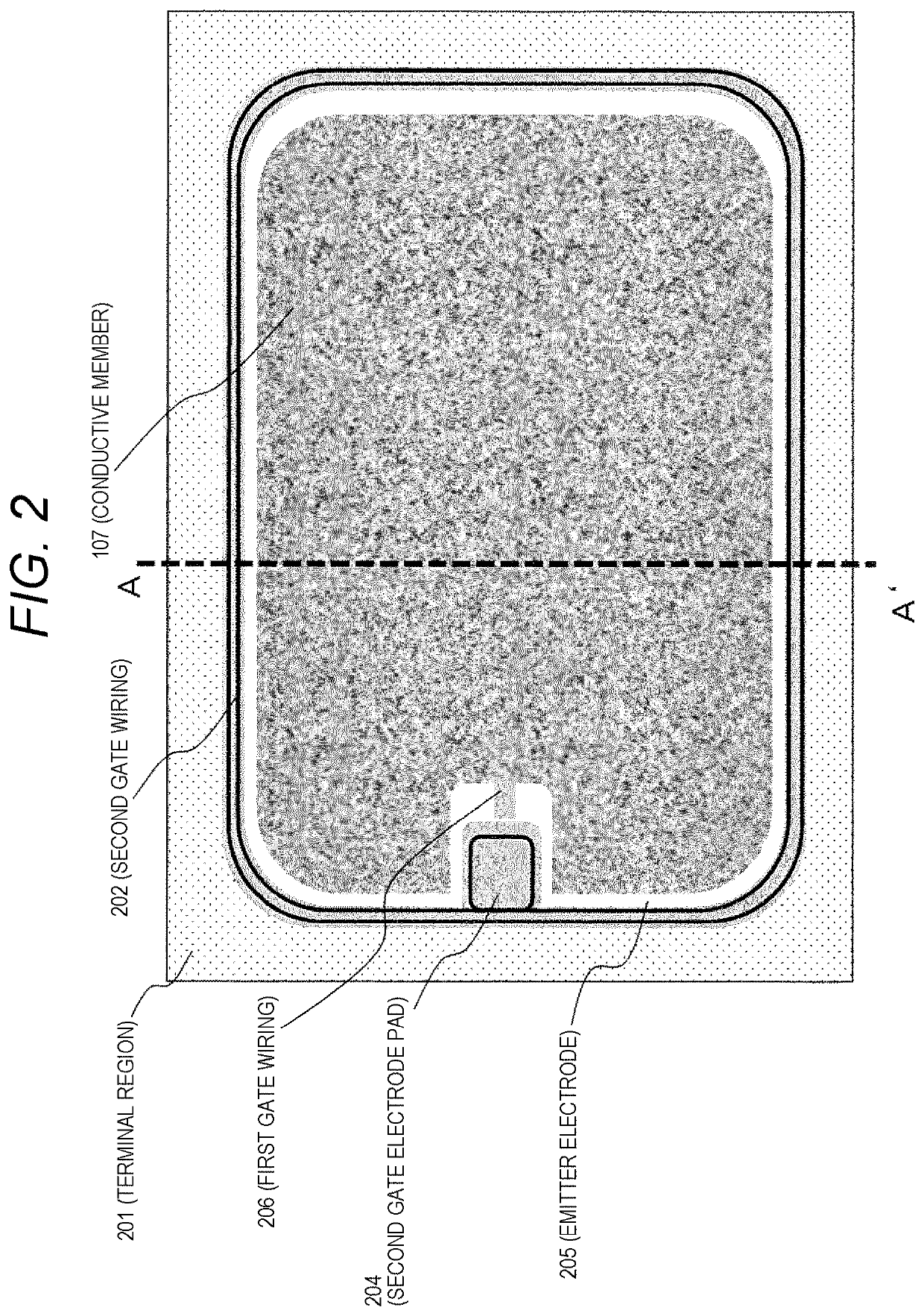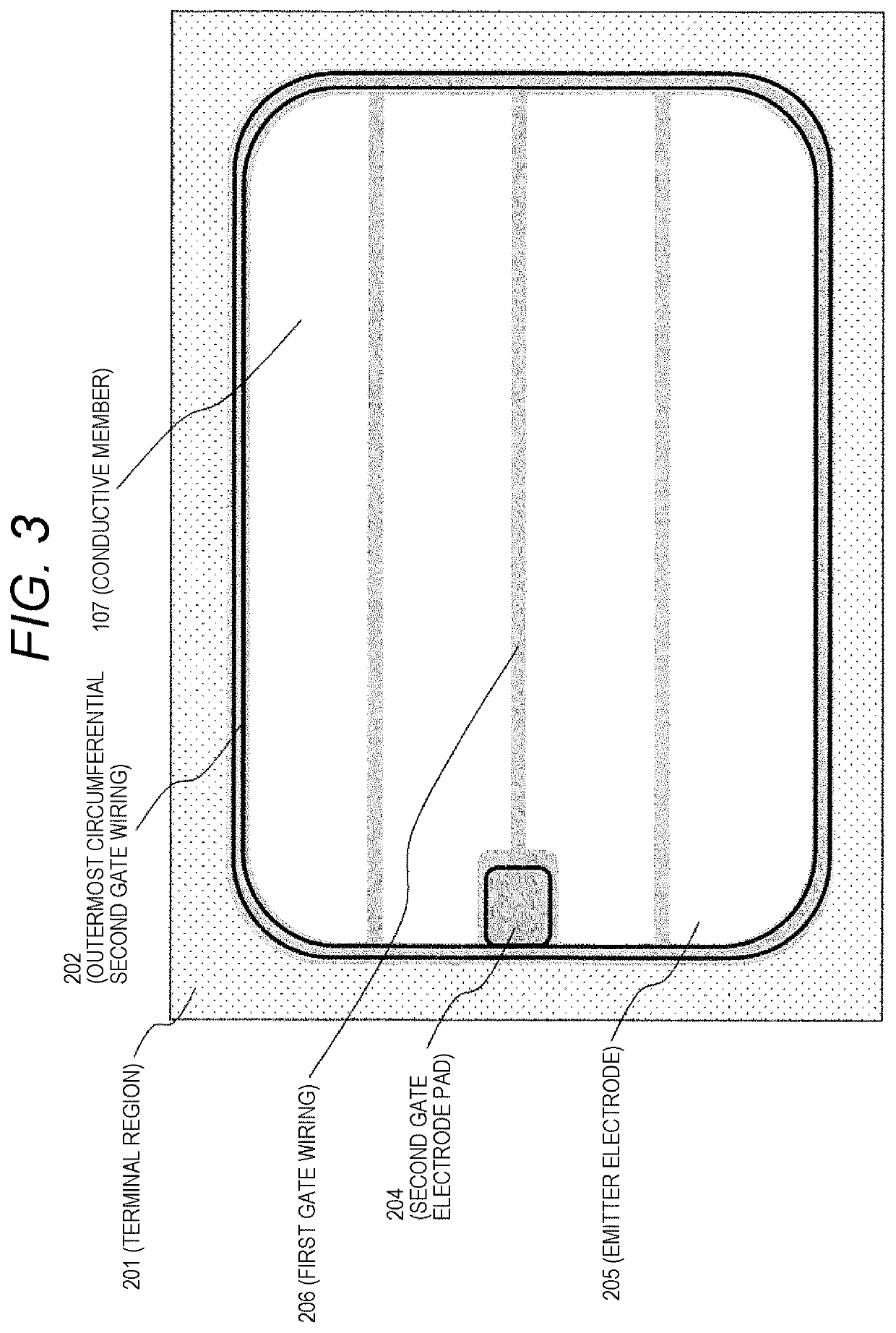Semiconductor device and power conversion apparatus
a technology of semiconductor devices and power conversion apparatus, which is applied in the direction of semiconductor devices, solid-state devices, basic electric elements, etc., can solve the problems of undiscovered effective materials as alternatives to “high-temperature solder” and severely restricted use of lead, and achieve the effect of reducing characteristic defects and suppressing excessive stress
- Summary
- Abstract
- Description
- Claims
- Application Information
AI Technical Summary
Benefits of technology
Problems solved by technology
Method used
Image
Examples
example 1
[0039]FIG. 1 is a top view of a semiconductor device according to Example 1 which is a first embodiment of the present invention. Further, FIG. 2 is a top view illustrating a mounting mode of a portion of the IGBT chip in the semiconductor device of FIG. 1. Further, FIG. 3 is a top view of the portion of the IGBT chip in the semiconductor device of FIG. 1. Further, FIG. 4 is a cross-sectional view illustrating a configuration of a cross section of the semiconductor device taken along a line A-A′ of FIG. 1.
[0040]The semiconductor device of this example is an example of the case of being applied to an IGBT module. Incidentally, the configuration of using a module in which an IGBT chip and a freewheel diode chip are mounted on a common collector wiring on a ceramic substrate as the semiconductor device will be described in this example, but the present invention is not limited to this configuration. It is possible to similarly apply a technical idea of the present invention even to, fo...
example 2
[0053]FIG. 12 is a layout diagram of a main part of a portion of the IGBT chip in a semiconductor device according to Example 2 which is a second embodiment of the present invention. Further, FIG. 13 is a bird's-eye view of a region E of FIG. 12. Parts having the same configurations as those of Example 1 will be denoted by the same reference numerals, and the overlapping part will not be described.
[0054]A feature of this example is that the active portion gate wiring 504 is buried in a trench portion to form a buried gate wiring 1201, which is different from Example 1. The other matters are common to those of Example 1. The buried gate wiring 1201 is formed in the same step as the trench gate 501, and the trench gate 501 and the buried gate wiring 1201 are connected in the trench. As compared with Example 1, it is possible to further reduce a difference in level between the active portion gate wiring 504 and the emitter electrode 205. Pressure at the time of connecting the conductiv...
example 3
[0055]FIG. 14 is a layout diagram of a main part of a portion of the IGBT chip in a semiconductor device according to Example 3 which is a third embodiment of the present invention. Further, FIG. 15 is a bird's-eye view of a region F of FIG. 14. Parts having the same configurations as those of Examples 1 and 2 will be denoted by the same reference numerals, and the overlapping part will not be described.
[0056]In the semiconductor device of this example, a gate is formed as a sidewall gate 1403 which is a type of a side gate structure, and the gate wiring 504 in the active portion is formed as a buried sidewall-type gate wiring 1402 and is connected to the sidewall gate 1403. This example is characterized by this point, and is different from Examples 1 and 2 in terms of this point. The other matters are common to those of Example 1.
[0057]A floating p layer 1202 is removed by providing a wide trench 1401. As a result, potential fluctuations of a gate due to influence of the floating p...
PUM
| Property | Measurement | Unit |
|---|---|---|
| particle diameter | aaaaa | aaaaa |
| particle size | aaaaa | aaaaa |
| pressure | aaaaa | aaaaa |
Abstract
Description
Claims
Application Information
 Login to View More
Login to View More - R&D
- Intellectual Property
- Life Sciences
- Materials
- Tech Scout
- Unparalleled Data Quality
- Higher Quality Content
- 60% Fewer Hallucinations
Browse by: Latest US Patents, China's latest patents, Technical Efficacy Thesaurus, Application Domain, Technology Topic, Popular Technical Reports.
© 2025 PatSnap. All rights reserved.Legal|Privacy policy|Modern Slavery Act Transparency Statement|Sitemap|About US| Contact US: help@patsnap.com



